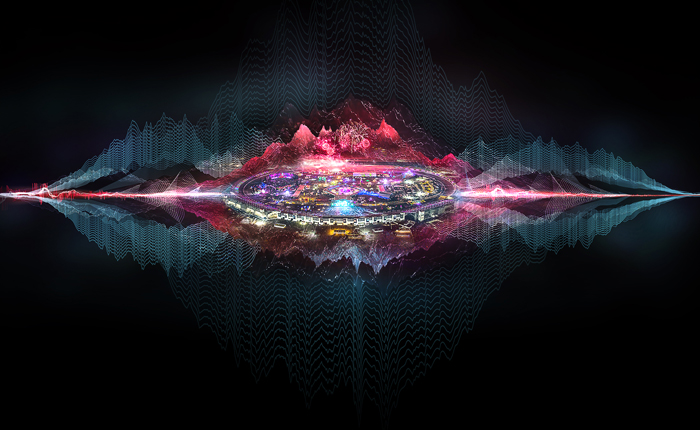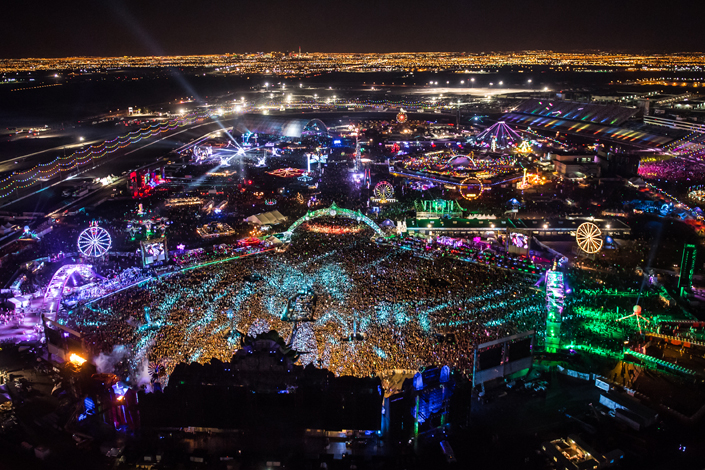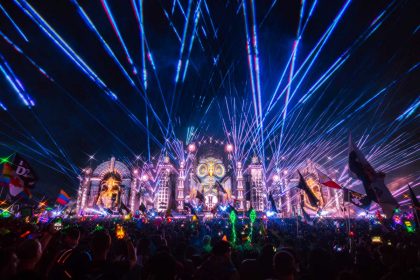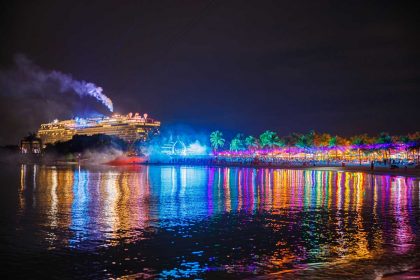The Sound of Science
As one of the festival’s most important pillars, sound is paramount to creating and progressing the full EDC experience.
Beyond the beats and bass, audio design is equal parts science and art; it’s more than just a stack of fat speakers. Each scenario and stage, every drop and BPM, create unique challenges. Facing those challenges is all part of delivering that sweet, sweet music to Headliners’ ears.

It all starts in the initial plotting of the festival grounds at the host venue, the Las Vegas Motor Speedway, a massive space that defies all laws of acoustics. Last year’s EDC Vegas covered roughly 910 acres of the Speedway’s 1,200 total acreage to host over 400,000 Headliners across three days. That’s a lot of humans, and with seven official stages and numerous roaming art cars—essentially speakers on wheels—figuring out how to smoothly direct such heavy traffic flow in a safe and efficient manner is the first step. Not a single speaker goes up onsite until the festival grounds are laid out and planned to the smallest detail.
“When it comes to placement, every festival’s venue inevitably becomes a Rubik’s Cube,” says Conor Bowes, Insomniac’s Director of Festival Experience. “The standard operating procedure for us is that stage placement comes first, and stage location often dictates how well we can take advantage of a venue. Fortunately, the Speedway affords us a blank canvas—and a large one, at that.”
This year’s EDC features a different festival layout, aimed to make the full festival grounds more accessible. With that comes more logistical changes. There is no copy-and-paste job when dealing with audio design at EDC. More change begets more variables.
Now, consider the most fluid variable of all: sound waves. Sound, in nature, is a tad unpredictable, with many dynamics affecting its course of travel. One of the main elements impacting the propagation of sound is weather and humidity. Sound travels as vibrations via a medium—air being the primary vehicle at the Speedway. Heavy and humid weather is more absorbent of sound waves and carries sound better, whereas dry air significantly attenuates it. As sound travels through the arid desert of EDC, its force diminishes via scattering and absorption, particularly when crossing a large area of space, making the Speedway the most challenging venue of all Insomniac-produced events. As proven in years past, Vegas weather fluctuates throughout the day; these temperature fluxes then alter directional frequency response, output and overall audio performance. But that’s not the full extent of the science.
Temperature and humidity affect higher-frequency sound waves—the treble and midrange sounds—more so than the low-end. That’s why you hear, and to an extent feel, the basslines of bassPOD at a farther distance than any other sound.

Wind, too, changes sound patterns. A steady wind blowing from the sound source in the same direction toward you will increase the sound; wind blowing away from you does the opposite. As sound initially travels upward into the atmosphere, wind can also potentially bend it back downward by refraction, which is when nearby neighborhoods start picking up the phone and making calls. Luckily for Vegas, the Speedway is far away enough from residential areas to avoid breaking noise ordinances. Thus, the party gets cranked up.
To help control the uncontrollable, Insomniac hires a large audio staff specifically tasked with operating sound on the fly across all stages. Squads of audio technicians control the overall sound configuration via sophisticated soundboards and systems, all the while communicating among the many teams to ensure a universal sound equilibrium. Through this practice, sound bleed—audio spill across stages—is minimized.
These strategic audio configuration plans help battle the uncertainty of nature via sizing, angling, and placement of the speakers and speaker towers. The smallest change in these factors causes noticeable audio effects. Speaker angling helps control vertical and horizontal dispersion of sound. Configuration helps steer sound waves via speaker placement and cancelation waves—again, particularly helpful when dealing with omnidirectional sub-frequencies (aka the bass). The name of the game is direction orientation—aiming the sound to hit exactly where it’s supposed to hit and nowhere else. When sound bleed is unavoidable, the teams create designated overflow areas managed throughout the event.
All of this is largely dependent on crowd attendance. There’s no reason to go to 11 before a stage reaches peak capacity, as it tends to happen in the earlier portions of EDC. It all points back to pivotal rule number one: Festival layout and its influence on the flow of traffic ultimately direct audio outcome.
With fewer than 50 days left ‘til the big show at the time of publishing, multiple audio design teams are still working hard on finalizing this year’s immense sound setup. kineticFIELD alone will require 368 speakers—146 of which are subs—11 speaker towers, and 3,600 amps of electricity. The goal: to create the quintessential audio experience for every single Headliner throughout all of EDC.
“When I started 20 years ago, there were a just a bunch of boxes, and you’d stack them on top of each other,” reflects Ian Gotts, Head of Stage Production at Insomniac.
While those days are far and gone, the future of audio design and the sound experience at EDC is limitless.
“We’re always going to be working on improving the sound, but there will never be a perfect sound,” says Gotts.






